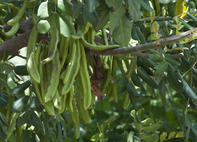The evergreen carob tree produces large green pods, which turn brown when ripe. The pods contain a sweet pulp and even-sized brown seeds. When ground up, the seeds produce a gum used for thickening foodstuffs.

The sweet pods, high in fibre are eaten by horses, cattle, pigs, goats and rabbits. Do not feed to chickens. Whole pods (and very hard seeds) should be crushed in a hammermill. Carob seeds are extremely hard and unless ground before feeding, may pass undigested through the animal’s digestive tract.
Carob seeds contain about 18% protein and 42 - 46% gum. Carob is high in tannins and should not make up more than 10% of an animal feed. These tannins interfere with protein digestibility. Carob seed flour is high in protein and is used in cattle feed as well as in dog biscuits.
Carob flour dissolves easily in water and can be used as a weaning diet for piglets, calves and other ruminants. Some farmers feed carob to their horses as part of a ‘cool feed’ (high fibre) or to replace sugary treats such as liquorice. The pods are ground in a hammermill, but some horses eat the pods directly from the ground.
Carob as rabbit feed was tested in an Egyptian study and it was found that including 5% of carob pods in the diet stimulated the performance of growing rabbits.
Carob for Sheep and Goats
Carob as animal feed for sheep was studied in research by the Kahramanmaras Sutcu Imam University in Bursa, Turkey. It was found that whole carob pods are a good potential energy source for sheep, but protein supplementation will be required when carob pods are included into ruminant diets.
In an Italian feeding study, it was found that carob pods have enough protein and energy to meet the maintenance and lactation requirements of lactating goats and sheep in semi-arid regions.
In dairy goats, a non-forage diet contains an adequate amount of fibre in the form of carob pods (26%) and beet pulp (27%). This ration could replace poor quality forage.
Carob as Pig Feed
Carob is suitable as a pig feed. A study performed in a commercial pig farm in Greece looked at how feeding carob affected meat quality in pigs. A total of 160 weaning piglets were fed diets, containing either 0 or 75 or 100 or 125 g of carob pods per kg of feed.
The results showed carcass weight was significantly higher with the addition of 75 or 100 g/kg carob pods. The use of carobs pods in pig feeding at the level of 125 g/kg feed did not have any effect on body weight. Carob pods are therefore suggested as a potential feed for fattening pigs.
Pig specialist and veterinarian Dr Jim Robinson, recommends using finely ground carob at no more than 5% of the feed and suggest feeding adult pigs first to assess their reaction. ‘The high tannin and sugar levels tend to suppress appetite in young pigs, although the energy content would be OK.
Stick with 5% as a cost saver unless the carob is being processed and sold with a reliable analysis to go with it. Only then you may try to increase it to make up 10% of your feed mix.’
Please note: Information is for educational and informational purposes only and may not be construed as nutritional advice. The information is not intended to replace advice or feed formulations offered by animal nutritional professionals.
By Marinda Louw